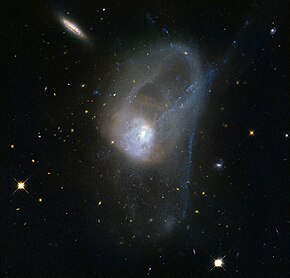
Back NGC 3921 Arabic NGC 3921 Azerbaijani NGC 3921 Byelorussian NGC 3921 BS NGC 3921 CE NGC 3921 German NGC 3921 DIQ NGC 3921 Esperanto NGC 3921 Basque انجیسی ۳۹۲۱ Persian
| NGC 3921 | |
|---|---|
 NGC 3921, imaged by the Hubble Space Telescope | |
| Observation data (J2000 epoch) | |
| Constellation | Ursa Major |
| Right ascension | 11h 51m 06.863s[1] |
| Declination | +55° 04′ 43.38″[1] |
| Redshift | 0.019667[2] |
| Heliocentric radial velocity | 5896 km/s[2] |
| Distance | 277.9 Mly (85.19 Mpc)[3] |
| Apparent magnitude (V) | 12.64[4] |
| Apparent magnitude (B) | 13.4[4] |
| Absolute magnitude (V) | −22.09[5] |
| Characteristics | |
| Type | (R')SA0/a(s) pec[2] |
| Size | 180,200 ly (55,240 pc)[2][note 1] |
| Apparent size (V) | 2.1′ × 1.3′ |
| Other designations | |
| Arp 224, UGC 6823, MGC+09-20-009, PGC 37063 | |
NGC 3921 is an interacting galaxy in the northern constellation of Ursa Major. Estimates using redshift put it at about 59 million light years (18 megaparsecs) from Earth.[3] It was discovered on 14 April 1789 by William Herschel,[6] and was described as "pretty faint, small, round" by John Louis Emil Dreyer, the compiler of the New General Catalogue.[7]
NGC 3921 is the remnant of a galaxy merger. The two progenitor galaxies are thought to have been disk galaxies that collided about 700 million years ago.[8] The image shows noticeable star formation and structures like loops, indicative of galaxies interacting.[8] Because of this, NGC 3921 was included in Halton Arp's Atlas of Peculiar Galaxies under the designation Arp 224.[4]
Being a starburst galaxy, NGC 3921 has important features. One of them is an ultraluminous X-ray source, designated X-2, with an X-ray luminosity of 8×1039 erg/s.[9] Additionally, two candidate globular clusters have been detected within NGC 3921.[5] They are both fairly young, and about half as massive as Omega Centauri, demonstrating that mergers of gas-rich galaxies can also create more metal-rich globular clusters.[5]
- ^ a b Skrutskie, Michael F.; Cutri, Roc M.; Stiening, Rae; Weinberg, Martin D.; Schneider, Stephen E.; Carpenter, John M.; Beichman, Charles A.; Capps, Richard W.; Chester, Thomas; Elias, Jonathan H.; Huchra, John P.; Liebert, James W.; Lonsdale, Carol J.; Monet, David G.; Price, Stephan; Seitzer, Patrick; Jarrett, Thomas H.; Kirkpatrick, J. Davy; Gizis, John E.; Howard, Elizabeth V.; Evans, Tracey E.; Fowler, John W.; Fullmer, Linda; Hurt, Robert L.; Light, Robert M.; Kopan, Eugene L.; Marsh, Kenneth A.; McCallon, Howard L.; Tam, Robert; Van Dyk, Schuyler D.; Wheelock, Sherry L. (1 February 2006). "The Two Micron All Sky Survey (2MASS)". The Astronomical Journal. 131 (2): 1163–1183. Bibcode:2006AJ....131.1163S. doi:10.1086/498708. ISSN 0004-6256. S2CID 18913331.
- ^ a b c d "NED results for object NGC 3921". National Aeronautics and Space Administration / Infrared Processing and Analysis Center. Retrieved 28 May 2017.
- ^ a b Crook, Aidan C.; Huchra, John P.; Martimbeau, Nathalie; Masters, Karen L.; Jarrett, Tom; Macri, Lucas M. (2007). "Groups of Galaxies in the Two Micron All Sky Redshift Survey". The Astrophysical Journal. 655 (2): 790–813. arXiv:astro-ph/0610732. Bibcode:2007ApJ...655..790C. doi:10.1086/510201. S2CID 11672751.
- ^ a b c "NGC 3921". SIMBAD. Centre de données astronomiques de Strasbourg. Retrieved 28 May 2017.
- ^ a b c Schweizer, François; Seitzer, Patrick; Brodie, Jean P. (2004). "Keck Spectroscopy of Two Young Globular Clusters in the Merger Remnant NGC 3921". The Astronomical Journal. 128 (1): 202–210. arXiv:astro-ph/0404424. Bibcode:2004AJ....128..202S. doi:10.1086/421851. S2CID 14568163.
- ^ Seligman, Courtney. "New General Catalogue objects: NGC 3900 - 3949". cseligman.com. Retrieved 28 May 2017.
- ^ "Revised NGC Data for NGC 3921 - Hartmut Frommert - SEDS". seds.org. Retrieved 28 May 2017.
- ^ a b "Evolution in slow motion | ESA/Hubble". www.spacetelescope.org. 2015. Retrieved 28 May 2017.
- ^ Jonker, P. G.; Heida, M.; Torres, M. A. P.; Miller-Jones, J. C. A.; Fabian, A. C.; Ratti, E. M.; Miniutti, G.; Walton, D. J.; Roberts, T. P. (2012). "The Nature of the Bright Ulx X-2 in Ngc 3921: Achandraposition Andhstcandidate Counterpart". The Astrophysical Journal. 758 (1): 28. arXiv:1208.4502. Bibcode:2012ApJ...758...28J. doi:10.1088/0004-637X/758/1/28. S2CID 59330131.
Cite error: There are <ref group=note> tags on this page, but the references will not show without a {{reflist|group=note}} template (see the help page).